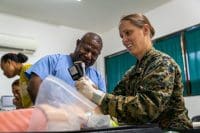Patient-centered care focused on self-sufficiency
- Only 11% of RNs work in home health.
- Home health continues to grow because of its association with shortened hospital stays, better treatments to manage chronic conditions, and the growing population of adults 85 years and older.
- Home-based professional nursing requires a unique set of knowledge and skills focused on care coordination, home assessment, direct patient care, team leadership, health promotion, and patient education related to self-care.
The Centers for Medicare and Medicaid Services (CMS) uses the term “home health” to describe a federal health insurance program that provides intermittent short-term care to help patients recover from illness and become as self-sufficient as possible at home. Professionals who participate in home health include nurses, physical therapists, occupational therapists, speech therapists, social workers, and nurse aides. Home care can be provided in-person or virtually via audio-only or audio–video platforms.
According to the U.S. Bureau of Labor Statistics, only 11% of RNs work in home health; however, this practice area continues to grow because of its association with shortened hospital stays, better treatments to manage chronic conditions, and the growing population of adults 85 years and older projected to double in the coming decade. The National Center for Health Statistics estimates that nearly 5 million patients receive home healthcare in the United States each year. The National Association for Home Care and Hospice recently reported that the supply of nurses can’t sufficiently meet the demand for these services.
How home care works
Based on Medicare regulations, a patient can begin home healthcare after a physician or allowed provider (nurse practitioner, clinical nurse specialist, or physician assistant) refers them to home health services. Home health agency staff then visit the patient to assess their needs, identify whether the patient is homebound and eligible for home health, and discuss services. Typically, RNs make the initial evaluation visit. After the assessment, a physician or allowed provider signs orders (which include the patient’s plan of care) for home healthcare.
The nurse’s role
Home-based professional nursing requires a unique set of knowledge and skills focused on care coordination, home assessment, direct patient care, team leadership, health promotion, and patient education related to self-care. The American Nurses Association’s Home Health Nursing: Scope and Standards of Practice provides an overview of expectations and competencies of the professional nurse. In addition, the International Home Care Nurses Organization provides descriptive statements to guide home care nursing practice.
Linda’s first visit of the day is with Mrs. Rogers, who’s 80 years old and lives alone. Mrs. Rogers returned home from the hospital a week ago after treatment for pneumonia. Her respiratory status continues to improve, but she still requires nursing assessment and treatment education. In addition, Mrs. Rogers receives physical therapy to improve her strength. This is Linda’s third visit as they progress through the plan of care.
Before leaving for the visit, Linda reviews Mrs. Rogers’ care plan, prior teaching, and the physical therapist’s visit notes. She calls Mrs. Rogers to say that she’s on the way and will arrive in 15 minutes. This call ensures that Mrs. Rogers is expecting Linda and that she has her medications available for review.
After arriving and greeting Mrs. Rogers, Linda performs a physical assessment and answers Mrs. Rogers’s questions about her recovery, documenting the information on the agency’s electronic tablet, which Linda carries with her. Linda reviews with Mrs. Rogers the teaching she provided at prior visits and discusses the plan for this visit. Their care goals include helping Mrs. Rogers independently place medications in the pill container once a week and take them as prescribed twice a day. Mrs. Rogers self-administered medication before her hospitalization, but several new medications have been prescribed. Mrs. Rogers says that she’s taking the medications morning and evening. Linda checks the 7-day, twice-a-day pill container and sees that the medications are gone from the appropriate compartments.
During this visit, Linda sits beside Mrs. Rogers at the kitchen table and provides coaching as Mrs. Rogers places over-the-counter and prescription medications into the container consistent with instructions on the medication bottles and the written list signed by the certifying provider. Using the teach-back method, Linda and Mrs. Rogers review the reason for and use of each medication as well as their risks, benefits, and side effects. Mrs. Rogers expresses gratitude for the review and a little uncertainty about taking the new medications correctly but gains confidence as her energy and understanding increase.
Linda and Mrs. Rogers then call Mrs. Rogers’s daughter to apprise her of progress in medication self-management. Linda completes her documentation in the electronic health record during the 40-minute visit. Documentation at the site of care ensures the most accurate information, makes the notes immediately available to other clinicians on the team, and allows Linda to free her mind to focus on the next patient’s visit.
Before leaving, Linda and Mrs. Rogers review the schedule for the week, noting that the physical therapist will visit tomorrow. When several professionals participate in care, visits are spaced so that they occur on as many days of the week as possible rather than multiple visits on one day. The physical therapist also will check the pill container to see if medication is gone from the appropriate compartments and ask Mrs. Rogers whether she has any prescribed changes or concerns about taking medication appropriately. The physical therapist will inform Linda of any problems.
Linda continues with her other home visits. In the afternoon, she receives a call from the home health agency scheduler asking her to admit a new patient who was discharged from the hospital today. Linda accepts the assignment and contacts the prospective patient, telling him what time she’ll arrive. Linda uses her tablet to read the patient’s health record and physician orders. She’s prepared for the admission with the needed supplies organized in bins in the trunk of her agency car.
This visit, which will take at least an hour to complete the comprehensive physical and psychosocial assessment, changes the length of Linda’s workday. She had planned to pick up her children after school but now arranges for a family member to collect them. The home health schedule provides Linda with flexibility during the day but also requires her to accommodate patient schedules. Linda completes as much of the patient assessment as possible during the visit and will finish and electronically submit it within 24 hours to ensure its availability for other clinicians before they visit this new patient.
Home-based nursing practice framework
I propose a theoretical framework with six key concepts and four relational statements to describe the experiences of patients and providers in the patient’s home. This framework shows how nursing care in the home differs from care provided in other settings. It also helps nurses understand their role and guides home care practice, education, and administration. (See Home care framework.)
Home care framework
The following framework helps to guide home-based nursing practice.
6 concepts and definitions
- Primacy of home—A home has both a personal meaning and a physical environment that determines opportunities and limitations for self-care.
- Patient authority—The patient has decision-making power in the home.
- Patient self-management—Care focuses on improving the patient’s self-efficacy and self-care ability.
- Caregivers as collaborators—Family caregivers participate in the plan of care.
- Interprofessional team collaboration—The nurse promotes communication and coordination of care among team members for the patient’s benefit.
- Nurse autonomy—One-on-one care in the home requires that the nurse use advanced assessment and communication skills.
4 theoretical statements
- The personal meaning of home and the physical home environment shape the patient’s beliefs, habits, and self-management actions.
- The patient has ultimate decision-making control and authority over their own health-related behaviors in the home.
- Home-based care includes interprofessional teams to provide person-centered care and maximize the patient’s self-management ability.
- The autonomous home-based nurse works alone in the home with the patient/caregiver and has primary responsibility for holistic assessment and intervention.
Source: Hinck 2022
Home-based nursing care differs from care in other settings in several important ways. First, we must acknowledge that the home belongs to the patient and the nurse enters as a guest. This means asking permission before handling medication bottles or other items in the home. Also, the nurse asks the patient to identify personal goals and ensures they understand the evidence-based plan of care and why they’re receiving home care (why the nurse is there). The certifying provider’s orders for home healthcare serves as instructions for the home health agency to help the patient improve and become self-sufficient and safe at home. However, the plan works only if the patient agrees with it. The home health nurse also has responsibility for tailoring the individualized care plan to fit patient preferences, the unique home setting, and the resources available.
The home environment differs for each patient, which requires the nurse (and other professionals) to ensure the patient completes self-care. A patient’s ability to take care of themselves may require alterations in the home environment or changes in activities, living patterns, and habits. To achieve these goals, the family and caregivers who assist the patient must participate in the care plan. (See 5 tips for successful home care.)
5 tips for successful home care
The following tips can help ensure a successful home care experience for nurses and patients.
- Patient teaching at hospital discharge may not prepare the patient to safely follow through at home. The home health nurse must read the hospital discharge instructions and orders and then fully assesses the patient’s understanding of medication use, treatments, and follow-up medical care.
- Home health documentation of patient progress toward goals must occur at each visit, whether in-person or remotely. Insurers limit the number of home visits allowed, so every visit should move the patient toward goal completion.
- Patient engagement should focus on what’s important to the individual. Patients will more likely experience lasting improvement in health and self-care ability if they agree with the plan of care and proposed interventions.
- A comprehensive assessment includes observing patient self-care and not relying solely on patient or family/caregiver report. For example, if a patient’s husband says he doesn’t need help placing medication in the pill box, the nurse should check to ensure that it’s filled correctly. The nurse’s actions should include the patient and caregiver and not isolate or offend them.
- Professional nurses should continuously assess their own learning needs and seek educational opportunities. A clinical community of coworkers can share resources, discuss solutions to clinical challenges, and provide emotional support. In addition, clinical mentors can provide guidance in understanding the nursing role in the home, how nurses should present themselves to the patient, and how to work with the interprofessional team and other medical and community resources.
Challenges
Home-based nursing includes unique challenges but also opportunities for greater autonomy in practice. Home environments and living situations vary, sometimes because of economic limitations or personal choices. Nurses in the home must remain nonjudgmental when their values or preferences differ from those of the patient. Being alone with the patient in the home requires the nurse to stay organized and ensure they’re prepared with all needed supplies and a plan for assessment and teaching. The nurse must use time efficiently to complete assigned visits, documentation, and communication with family and team members.
Home visits sometimes require clinicians to travel in inclement weather, over rough roads, and in unfamiliar neighborhoods. Orientation and continuing education should provide nurses with personal safety strategies in communities and homes.
In addition, nurses must balance their autonomy as a central caregiver in the home with their leadership role in coordinating teams, which may include therapists, medical social workers, primary care and specialty medical providers, pharmacists, and other community resources. The satisfaction of providing one-on-one personalized care offsets any challenges associated with home-based nursing.
A team approach
Successful person- and family-centered home care requires an interprofessional team-based approach. Interprofessional care entails more than professionals from different disciplines working within their customary distinct boundaries (multidisciplinary care) and then reporting to the team. In a landmark article, Choi and Pak present interprofessional care that transcends traditional disciplinary boundaries to share expertise and closely coordinate interventions. For example, in home healthcare, all professions participate in the patient’s medication self-management and physical safety. Any changes in the plan of care recommended by the team require approval by and a prescription from the home health certifying provider. Communication via the electronic health record, email, phone, and team conferences offers opportunities to share information among team members regarding the patient’s progress. The successful outcome of home healthcare is a self-confident and self-sufficient individual remaining safe at home.
*Names are fictitious.
Susan Hinck is the owner of Susan Hinck Consulting LLC in Springfield, Missouri, and President of the International Home Care Nurses Organization (ihcno.org).
American Nurse Journal. 2024; 19(6). Doi: 10.51256/ANJ0624134
References
Agency for Healthcare Research and Quality. Health literacy universal precautions toolkit: Use the teach-back method: Tool #5. February 2024. ahrq.gov/health-literacy/improve/precautions/tool5.html
American Nurses Association. Home Health Nursing: Scope and Standards of Practice. 2nd ed. Silver Spring, MD: American Nurses Association; 2014.
Centers for Disease Control and Prevention. Home health care. November 5, 2023. cdc.gov/nchs/fastats/home-health-care.htm
Centers for Medicare and Medicaid Services. Chapter 7 – Home health services. In: Medicare Benefit Policy Manual. December 21, 2023. cms.gov/Regulations-andGuidance/Guidance/Manuals/Downloads/bp102c07.pdf
Choi BCK, Pak AWP. Multidisciplinarity, interdisciplinarity, and transdisciplinarity in health research, services, education, and policy: 1. Definitions, objectives, and evidence of effectiveness. Clin Invest Med. 2006;29(6): 351-64
Hinck SM. A theoretical framework of home-based professional nursing practice. Home Healthc Now. 2022;40(3):146-53. doi:10.1097/NHH.0000000000001063
Hinck SM. Becoming an expert home health nurse. Home Healthc Now. 2021;39(5):271-7. doi: 10.1097/NHH.0000000000000990
Hinck SM. Incorporating virtual visits into the home health plan of care. Home HealthC Now. 2021;39(3):128-34. doi:10.1097/NHH.0000000000000962
Narayan M, Farris C, Harris MD, Hiong FY. Development of the International Guidelines for Home Health Nursing. Home Healthc Now. 2017;35(9):494-506. doi: 10.1097/NHH.0000
000000000604
National Association for Home Care and Hospice. The home care workforce crisis: An industry report and call to action. March 2023. nahc.org/wp-content/uploads/2023/03/Workforce-Report-and-Call-to-Action-Final_03272023.pdf
U.S. Bureau of Labor Statistics. Occupational employment and wages, May 2022: Registered nurses. April 25, 2023. www.bls.gov/oes/current/oes291141.htm
Key words: home health, patient-centered care, home-based nursing


















